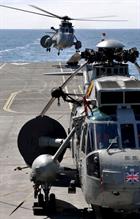854 NAS bag where they belong
After five years of land-based operations in Afghanistan, the Royal Navy’s Sea King Force has fully returned to sea, flying their helicopters from Royal Navy ships in the Gulf.
Whilst operating from Camp Bastion since May 2009, the ‘Sea King Airborne Surveillance and Control (SKASaC) Force’, nicknamed ‘The Baggers’, used hi-tech surveillance systems developed to protect Navy ships at sea, to detect and locate smuggling routes used by the Taliban.
Flying Mk7 Sea King helicopters fitted with some of the most advanced radar and sensor systems available, the specialist aircrew operated airborne radar stations to provide a protective radar ‘shield’ around Coalition forces on the ground.
In five years of unbroken commitment, the Baggers helped to locate arms caches, tracked drugs shipments and followed the movements of insurgents.
Now that the UK is drawing down from Afghanistan, the role of the Sea King Force in that theatre is complete.
Never idle, the Cornwall-based aviators have been preparing to return to sea based operations and will now focus on protecting ships in the Gulf region.
Personnel from 854 Naval Air Squadron, usually based at Royal Naval Air Station Culdrose, led the first deployment into this theatre earlier this year.
The Commanding Officer of 854 Naval Air Squadron, Lt Cdr Roger Kennedy said: “The men and women of the Sea King ASaC force did a fantastic job adapting to the role in Afghanistan.
“Now we need to regain skills that will have faded in that time, and re-adapt to ship-borne operations.”
Operating safely at sea requires a lot of training as Lt Jon Duke, one of the Sea King Pilots based in the Gulf explains: “A ship’s flight deck is one of the most challenging environments from which to operate aircraft.
“Safe operations are completely dependant on the professionalism and interaction between the aircrew, engineers and ship’s company.”
Lt Cdr Kennedy’s team laid the foundations for the sea-based deployment and sister squadron, 857 joined them this month to take the Sea King helicopters back to sea.
Commander Victoria Dale-Smith, the Sea King Force Commander said that the success of her Force was due to the flexibility of personnel and the capabilities of the technology onboard the aircraft, she said: “The Mk7`s powerful radar is capable of detecting movement over the sea, the coastal environment and over land.
“This and the flexibility of our personnel, enable the Sea King Force to operate to high effect in a variety of environments.
“The Force has proven its worth operating over the land, now it is time that we regain our sea legs and show what we can do in our traditional maritime role.”



